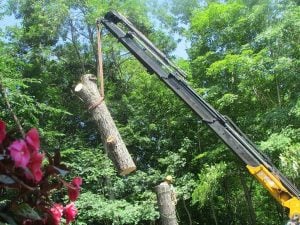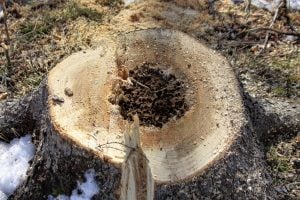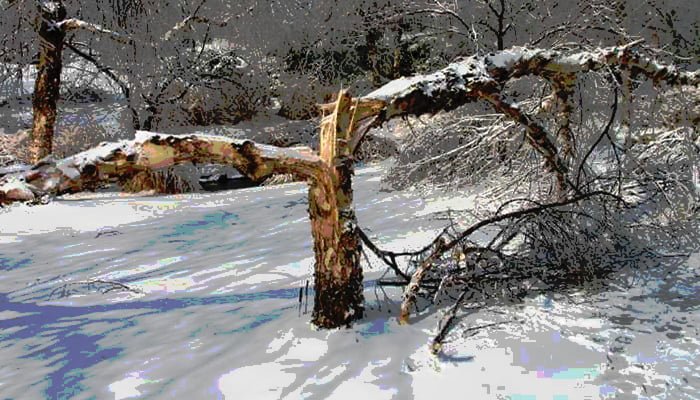It is important that your trees go into winter prepared. Tree winter prep encompasses a few different things including; inspection, tree removal, stump removal, and winterization methods.
Inspection:
Inspection of your property and all trees within 100 FT of your home should be completed before the first snow storm. During inspection, your professional arborist will be checking for things like:
- Dead or dying trees
- Dead parts of live trees
- Instability of any kind
- Breakage potential
- Growth into powerlines
- Dangerous leaning
- Trees that are simply too large for your property
Tree Removal:
 Following inspection, trees deemed as hazardous during inspection will need to be removed. This may mean simply removing part of the tree, like weak and hazardous limbs, or it could mean removing the entire tree, depending on the severity of the issues. If hazard limbs/trees are not dealt with before winter, this could mean trouble for your property when the added weight of snow and ice stresses the already weak tree. This added weight to a weakened tree or branch can result in costly and devastating damages to what is below the tree if it breaks/falls. Hazard limbs or weak areas of a tree are not often noticeable to an untrained eye and this is why professional inspection is so important.
Following inspection, trees deemed as hazardous during inspection will need to be removed. This may mean simply removing part of the tree, like weak and hazardous limbs, or it could mean removing the entire tree, depending on the severity of the issues. If hazard limbs/trees are not dealt with before winter, this could mean trouble for your property when the added weight of snow and ice stresses the already weak tree. This added weight to a weakened tree or branch can result in costly and devastating damages to what is below the tree if it breaks/falls. Hazard limbs or weak areas of a tree are not often noticeable to an untrained eye and this is why professional inspection is so important.
Stump Removal:
 The best stump removal method is stump grinding as this removes the entire stump by grinding it into pieces. Removing any stumps on your property should always be the final step to tree removal. However, if you have stumps that have not been removed, they should be before the first snowfall. Once the ground and soil are frozen, stump grinding becomes very tough, and harsh on the machinery. Because of this, stump grinding is often not done in the winter. Failure to remove stumps after tree removal can result in:
The best stump removal method is stump grinding as this removes the entire stump by grinding it into pieces. Removing any stumps on your property should always be the final step to tree removal. However, if you have stumps that have not been removed, they should be before the first snowfall. Once the ground and soil are frozen, stump grinding becomes very tough, and harsh on the machinery. Because of this, stump grinding is often not done in the winter. Failure to remove stumps after tree removal can result in:
- Disease – A left behind stump from a diseased tree can result in the potential to spread to healthy trees on your property.
- Growth – Leaving a stump means its roots are still intact which could lead to ugly weed growth around the stump.
- Insects and infestation – Termites love dead trees and wood. A freshly cut stump is a much-desired home for termites. If your stumps are nearby to other wood possessions on your property, like your home or a deck, they may start to also feed on and damage these areas.
- Hazard – If you have been on properties with tree stumps left behind (for example, a Christmas tree farm) you already know that stumps can be a big tripping hazard. Not only are stumps dangerous now, before the first snow storm, but imagine stumps on your property that you cannot locate (like after inches of snow are covering them). Stumps that are not removed can be particularly dangerous during the winter months for this reason.
Winterization Methods:
During the fall, your trees are transitioning to a dormant state. Mechanisms within the leaves called “senescence” essentially tell a tree when it’s time to “close up shop” for the winter. During the dormant months of a tree’s life, while they may look inactive, they do continue to regulate their metabolism. A dormant tree should be “winterized” to protect it from the harshness of those cold months.
- Pruning – Pruning dead and diseased branches in late fall can strengthen the tree and help to foster strong new growth come spring. Dormant pruning is also beneficial because it is easier to do at this time since the tree is bare and you have clear vision of the entire tree.
- Mulch – Mulching can help to regulate temperature and moisture within the root system during a time when the tree is very vulnerable to fluctuations.
- Fertilize – Fertilizing the top of your mulch layer can help to balance the root system if essential nutrients are in short supply (which is common in winter). But, proper fall application is necessary, as you do not want to foster later fall/winter growth.
- Water – Winter can be very drying. Water should be applied where soil is cool, but not frozen. Droughts are also common in winter, and while compensation is necessary, it is important not to over water.
- Wilt-Pruf Application – Apply Wilt-Pruf in late fall to add a protective coating onto your plants and trees that helps to hold in moisture and reduce water loss. Wilt-Pruf can even help trees that have natural survival skills like evergreens.
- Wrapping Boxwoods – Boxwoods are susceptible to winter burn because they originate from areas with milder winters. The above practices are important in protecting your boxwoods through winter, but you can also try wrapping them with a netting or burlap to protect from breakage in heavy snowfalls.
For any and all of your tree winter prep, contact Red Cedar Arborist & Landscapers today and get a free consultation! Haven’t begun your home’s winter prep? Now is the time to prepare your yard for winter before we see our first snow storm of the season!


